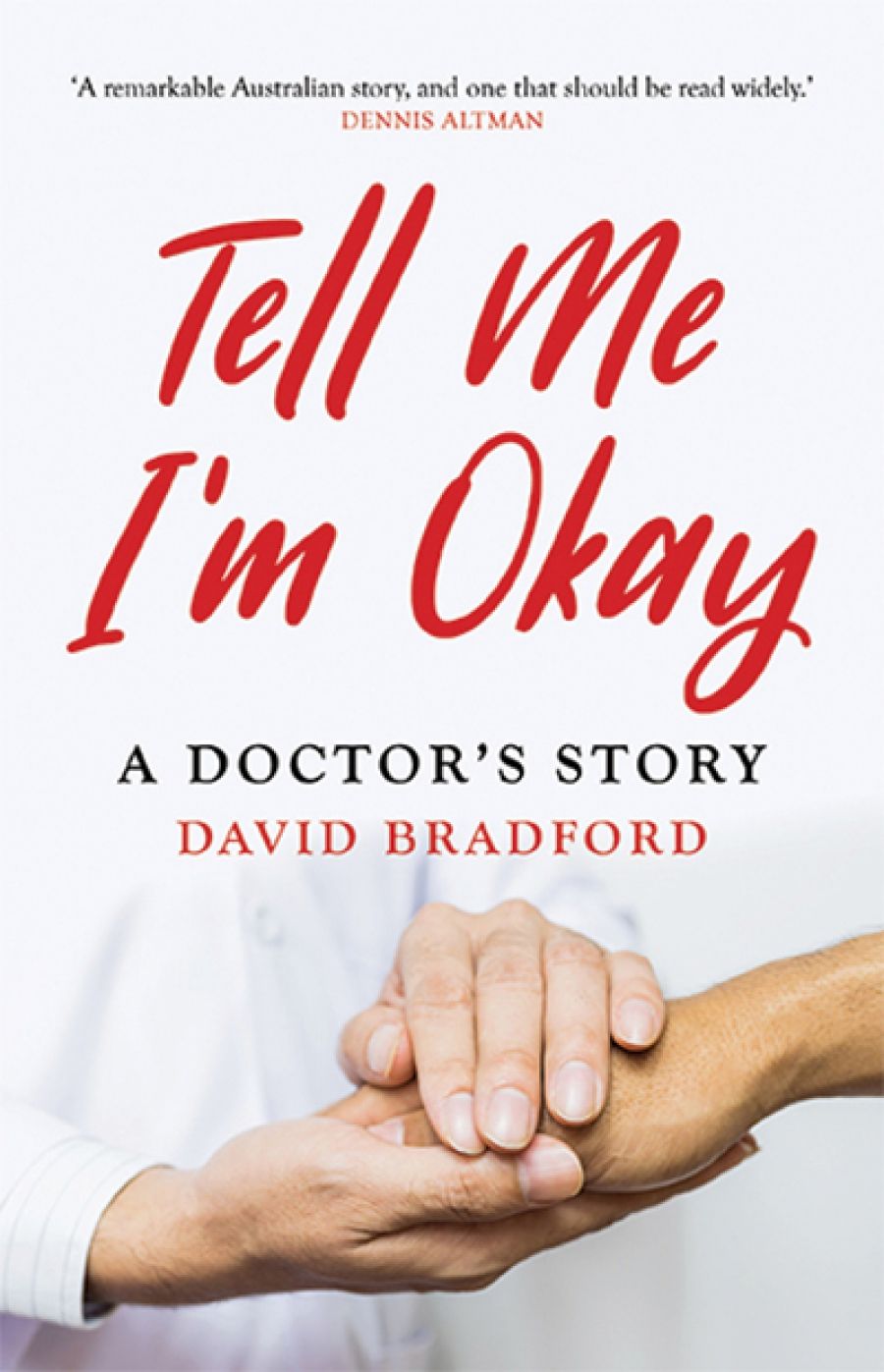
- Free Article: No
- Contents Category: Gay Studies
- Custom Article Title: Robert Reynolds reviews 'Tell Me I’m Okay: A Doctor’s Story' by David Bradford
- Review Article: Yes
- Online Only: No
- Custom Highlight Text:
Midway through this account of his life as a gay doctor who specialised in sexually transmitted infections, David Bradford diagnoses his first case of AIDS. It is February 1985 and Bradford is the director of the Melbourne Communicable Diseases Centre (MCDC) and the chief venereologist of Victoria. His patient James ...
- Book 1 Title: Tell Me I’m Okay
- Book 1 Subtitle: A Doctor’s Story
- Book 1 Biblio: Monash University Publishing, $29.95 pb, 226 pp, 9781925523348
This book is a personal, and personable, history of one doctor’s career in the HIV and STI sectors of the Australian medical profession. As an autobiography, it is primarily structured around Bradford’s homosexuality and the Australian AIDS epidemic. This is not surprising, for both sexual identity and AIDS tend to define Bradford’s generation of Anglo-Australian gay men. Bradford was born in 1941 and grew up in a deeply religious Baptist family in Sydney. His youth and early adulthood were marked by his conflicted and lonely struggles with his homosexual desires. He studied medicine at his parents’ behest and joined the army in the 1960s as a medico to be in tantalising but chaste proximity to men. Stationed in Vietnam during the war, he quietly appreciates the surfeit of handsome, well-built young men, and takes particular delight in the gunners who lay naked in the sunshine next to their armaments. The war provides Bradford with a heavy caseload of servicemen suffering venereal diseases, and he becomes fascinated with venereology and empathetic to the shame the diseases produce in his patients. In 1969, Bradford travels to London for further medical training and loses his virginity half a world away from home. Falling in love with his life partner in the 1970s, Bradford comes out to his parents and must navigate a resulting mist of parental disappointment that never lifts. By the early 1980s, now living in Melbourne, Bradford is contentedly partnered, happy professionally, and making new friends in Melbourne’s gay community.
It is not uncommon for those memorialising the impact of the AIDS epidemic on gay communities during the 1980s and 1990s to invoke comparisons with natural disasters and war. As Bradford recalls, for well over a decade he and his patients were ‘battered by the AIDS tsunami’. Waiting in Melbourne for the epidemic to arrive from the more populous gay metropoles of New York, San Francisco, and Sydney was ‘like living though the early days of World War II in Britain – the so called “phoney war”’. There was nothing phoney about the epidemic when it did encircle Melbourne’s gay community. Bradford’s fears about the future – which he had tried to quieten by faith in medical science – were soon realised. The number of unwell and frightened gay men trooping through his office quickened. Informing patients they had AIDS or were HIV positive ‘never got any easier’. How could it when, during that first decade of the epidemic, an AIDS diagnosis usually presaged a cycle of opportunistic infections before death? Bradford gives us an intimate account of what it was like to tend to patients – mostly gay men, but later increasing numbers of women and heterosexual men – as they came to terms, or not, with their diagnosis, fell ill. and died. Over a series of chapters, Bradford breaks the epidemic down into different historical stages: the wave on the horizon before the tsunami hit; the first diagnoses; debates over whether to test for HIV or not; the panic and fearmongering over infected blood supplies; the emotionally taxing years tending the dying at Fairfield Hospital; and the advent of new treatments in the mid-1990s that reshaped the Australian epidemic. In each of these chapters, Bradford introduces individual patients whose stories capture something larger about the epidemic.
 David Bradford
David Bradford
To describe these stories as clinical case studies would be to do a disservice to Bradford and his patients. There are some achingly sad stories in this book. James dies in 1987, a few months short of his thirtieth birthday. Trevor is turned away at a hospital and denied emergency surgery for appendicitis because he has AIDS; he never fully recovers from the delay in hospital admission. Martin, having moved to Melbourne to become a hairdresser and live a gay life, returns to his parents for his final months of life, barely in his twenties. ‘That’s the place for me now,’ he tells Bradford at their last consultation. The constant in these tragic stories is Bradford’s gentle, empathic ministering of care. It is the good doctor himself who offers his patients – and his readers – comfort in grim times.


Comments powered by CComment